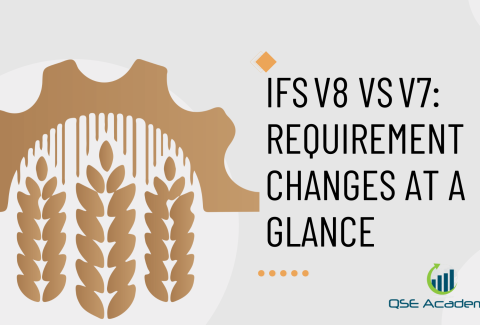IFS V8 Transition Gap‑Analysis Template
Last Updated on November 19, 2025 by Melissa Lazaro
Why an IFS V8 Gap-Analysis Template Matters During Transition
When a new version of a food safety standard comes out, most teams feel one of two things: overwhelm or uncertainty. I’ve seen it over and over while supporting facilities during version changes for IFS, BRCGS, ISO 22000, and FSSC. People ask the same question every time:
“Where do we even start?”
A gap-analysis template is your roadmap. Instead of guessing what needs updating, you can clearly see what already complies, what must change, and which areas need action before your next audit.
If you’re certified to IFS V7, this template will help you transition to IFS V8 in a structured, efficient way. It helps prevent rushed updates, overlooked requirements, or last-minute panic before the audit.
Understanding What Changed: Mapping IFS V7 to IFS V8 Requirements (Clause-by-Clause Comparison)
Before touching documents or training schedules, the first step is understanding the changes. IFS V8 doesn’t completely rewrite the framework, but some clauses are refined, merged, or expect stronger evidence.
A mapping table makes everything easier. It should include:
- Requirement description
- Status (new, modified, unchanged, removed)
- Level of impact (low, medium, high)
In my experience, companies that skip this step often waste time updating things that didn’t need changing — and accidentally miss areas auditors care about.
Small example:
Food Safety Culture is no longer just a statement. It now requires measurable actions, communication, and follow-up. So if your V7 documentation was a half-page policy, V8 will expect more.
 Documentation Review Section: Manuals, SOPs, Records, and Mandatory Forms
Documentation Review Section: Manuals, SOPs, Records, and Mandatory Forms
Once you understand what’s changed, the next step is reviewing documentation.
Your template should include space to assess:
- Whether your food-safety manual aligns with V8 structure
- If SOPs reflect revised requirement intent
- Whether forms and logs capture evidence required under V8
- Version control alignment between documents and operational records
A useful structure looks like this:
| Document | Requirement Reference | Status | Action Needed | Person Responsible | Due Date |
A common mistake?
Teams update the high-level manual and forget the forms that prove compliance — like allergen logs, internal audit checklists, or cleaning validation records.
Auditors check alignment, not just paperwork.
IFS V8 Scoring & Audit Expectations: Internal Audit Readiness Assessment
IFS V8 updates how audits are scored, especially around KO requirements. The changes aren’t drastic, but they matter.
This section of the template should help you assess:
- Whether internal audit checklists reflect V8 scoring
- If KO clauses are properly understood and documented
- Whether evidence for each requirement is objective and traceable
I’ve seen companies lose grading strength not because their system was weak — but because their internal audit methodology was outdated.
Pro tip:
Treat internal audits as a rehearsal. Use the same scoring logic, report layout, and evidence expectations your external auditor will apply.
Operational Controls and Food Safety Culture Review: Making Sure Practice Matches Policy
IFS V8 emphasizes culture — meaning the standard now expects proof that food safety isn’t just paperwork. It lives in behavior, awareness, and consistent execution.
Your template should include fields to evaluate:
- Training frequency and effectiveness
- Communication records (posters, meetings, toolbox talks)
- Evidence of leadership involvement
- Corrective action follow-through patterns
In real audits, you’ll feel this shift. Auditors are asking employees questions like:
“Who do you tell if something goes wrong?”
“Why is handwashing important?”
If the answers sound rehearsed or unclear, that signals a gap.
Risk-Based Requirements Review: HACCP/HARPC, PRPs, Suppliers, and Allergen Management
IFS V8 aligns more closely with updated Codex hazard analysis expectations. That means your hazard study must be current, justified, and validated using updated decision trees.
Your template should review:
- CCP and OPRP rationale
- Validation and verification evidence
- Supplier approval and risk classification
- Allergen controls
- Traceability and recall testing frequency
A common oversight is forgetting to update validation evidence, especially when nothing has changed operationally.
Auditors will still expect updated justification.
Implementation Priorities and Transition Action Plan: Assigning Ownership and Timelines
A gap-analysis is only valuable if it turns into action.
The final section of the template should help you prioritize based on:
- Risk level
- Effort required
- Audit impact
- Operational feasibility
A simple prioritization scale works well:
- High: Must be updated before audit
- Medium: Important but not audit-critical
- Low: Optional but beneficial
Assign responsibilities, due dates, and verification methods — and track progress monthly.
This avoids the classic scenario where everything is “in progress” with no proof.
FAQs — Common Questions About IFS V8 Transition Gap Analysis
1. Who should complete the gap-analysis?
Ideally, the Quality Manager leads it — but the process should involve HACCP team members, operational leads, and management.
2. How often should we update the gap-analysis during transition?
Most companies review it every 2–4 weeks until certification, depending on project size.
3. Can we reuse our IFS V7 documentation?
Yes — but most documents will need updates to reflect new expectations, scoring rules, and risk alignment.
Conclusion: Next Steps to Use the Template Effectively
Transitioning to IFS V8 is manageable when you follow a structured approach. A gap-analysis template helps you avoid scattered updates, missed changes, or rushed corrections before the audit.
If you commit to reviewing the clauses, assigning responsibilities, and updating evidence step-by-step, the transition becomes predictable — and certification feels far less stressful.
The next best move is simple:
Use the template, run your first internal review, and identify your top-priority actions.
Melissa Lavaro is a seasoned ISO consultant and an enthusiastic advocate for quality management standards. With a rich experience in conducting audits and providing consultancy services, Melissa specializes in helping organizations implement and adapt to ISO standards. Her passion for quality management is evident in her hands-on approach and deep understanding of the regulatory frameworks. Melissa’s expertise and energetic commitment make her a sought-after consultant, dedicated to elevating organizational compliance and performance through practical, insightful guidance.








